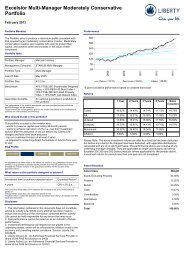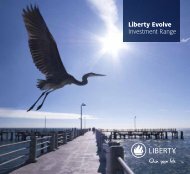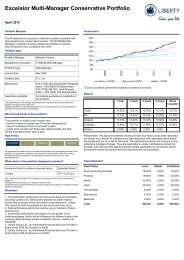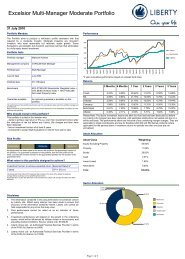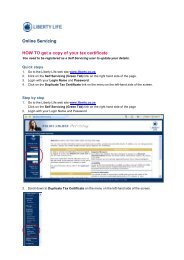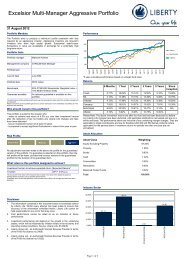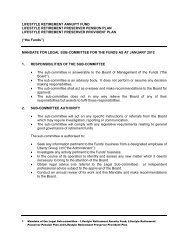The Weekly Focus (18 February 2013) - Liberty
The Weekly Focus (18 February 2013) - Liberty
The Weekly Focus (18 February 2013) - Liberty
You also want an ePaper? Increase the reach of your titles
YUMPU automatically turns print PDFs into web optimized ePapers that Google loves.
<strong>18</strong> <strong>February</strong> <strong>2013</strong>
Contents<br />
Newsflash ................................................................................................ 3<br />
Market Comment ................................................................................................... 3<br />
What does the Japanese stock market look like in dollar terms after its big run? ..................... 6<br />
JP Morgan note on SA fund managers .......................................................................... 6<br />
Snippets of Info ..................................................................................................... 7<br />
Economic Update ....................................................................................... 8<br />
<strong>Weekly</strong> Market Analysis ............................................................................... 10<br />
Rates .................................................................................................... 11<br />
Standard Bank Money Market Fund ............................................................................ 11<br />
STANLIB Enhanced Yield Fund .................................................................................. 11<br />
STANLIB Income Fund ............................................................................................ 12<br />
STANLIB Extra Income Fund ..................................................................................... 12<br />
Glossary of terminology .............................................................................. 13<br />
2
Newsflash<br />
Garzarelli expects the cyclical US bull market to stay in place for a long time –<br />
despite corrections along the way.<br />
Market Comment<br />
• As we look around at markets, we see a lot of commentators calling for a market correction,<br />
some - especially those sitting with too much cash - almost literally praying for a correction,<br />
even begging for one! (let me in, please!)<br />
• So far after 7 weeks of <strong>2013</strong>, the developed market MSCI World Index has returned 5.4% in<br />
dollars (10.9% in rands), the US S&P 500 Index is up 6.6%, Australia’s index is up almost 9% and<br />
the Japanese Nikkei Index is up 10% (although close to 0% in dollars, because the yen has fallen<br />
sharply).<br />
• <strong>The</strong> London FTSE Index is up 7.2% in sterling, but only 2.2% in dollars, because the pound has<br />
actually declined by about the same percentage as the rand (4.5%). <strong>The</strong> MSCI Europe excluding<br />
the UK Index has returned 4.6% in dollars (10.1% in rands).<br />
• <strong>The</strong> JSE All Share Index has returned 3.7% in rands, or -1.5% in dollars.<br />
• So, where to now? Well, on the one hand we have my favourite US market commentator, Elaine<br />
Garzarelli, saying that one of her indicators in her quantitative model, the number of bullish<br />
investment advisors in the US, actually declined last week from a reading of 54.7% to 52.6%.<br />
This means there were fewer bullish investment advisors, which is a market-positive sign, since<br />
excessive bullish levels are dangerous and a level above 53% is bearish for that indicator.<br />
• She says this modest retreat indicates a normal correction may be postponed. After all, there<br />
are so many people waiting for a pullback, that it may not actually happen, or at least not<br />
when everyone wants it or expects it, e.g. now. She says if this indicator continues to decline,<br />
she would upgrade it.<br />
• Otherwise her proprietary stock market indicator composite continues to be bullish at 80% and<br />
she says that she “expects this cyclical bull market to stay in place for a long time” -<br />
something that is somewhat unusual for her, because quantitative models like hers are always<br />
subject to change as conditions change.<br />
• On the other hand, we have Bank of America Merrill Lynch putting out an interesting research<br />
piece, wherein they say they like equities and are overweight, but expect a short-term pullback<br />
of 5-7%, because of what they call their new Bull & Bear Index (the “B&B”).<br />
• <strong>The</strong>y explain that movements in share prices are driven by many factors, such as the economy,<br />
government policy, earnings, interest rates and valuation; however, they think that tactical<br />
moves (less than 3 months) are often better explained by sentiment, positioning and technicals<br />
(the charts).<br />
3
• According to their new Bull & Bear Index investor sentiment towards risk assets is now at a<br />
more bullish level today than 99% of all readings since 2002. <strong>The</strong> current reading of 9.6 is close<br />
to maximum bullish (a reading of 10) and thus triggers a contrarian “sell” signal for risk assets<br />
like equities. <strong>The</strong>y hasten to point out that the index would have prompted a “buy” signal on<br />
June 5 th last year, one day after the equity market troughed. Interesting!<br />
• <strong>The</strong>ir back-testing shows that since 2002 a “sell” signal of 8.0+ would on average have been<br />
followed by a 12% peak-to-trough correction in global equities within 3 months.<br />
• <strong>The</strong>ir advice for longer-term investors is to therefore wait for a 5-7% correction before adding<br />
to positions. <strong>The</strong> plot thickens!<br />
• Something that can make a difference comes from a report compiled by UBS, saying equity<br />
holdings in pension funds globally are very low. In Germany, Italy, Spain and Japan they are<br />
below 20%. In the UK they are at a 30-year low of 44% in equities, yet this is one of the highest<br />
allocations. <strong>The</strong> peak allocation in the UK was 78% in 1993.<br />
• <strong>The</strong> US and Australia are two of the highest at around 50% of their pension funds in equities.<br />
• In Asia, both Japan and Korea have equity holdings below 10%!!<br />
• Insurance companies in Europe are even more risk-averse.<br />
• This suggests that even a small rotation back into equities by institutional investors could have<br />
a marked effect on the equity markets. This has not yet begun, says UBS. Growth in Europe<br />
would probably be the most powerful trigger (not happening yet) and losses in bonds could also<br />
spur a switch (losses have started, but in a small way).<br />
• <strong>The</strong> JP Morgan Global Government Bond Index is down 2.9% in dollar terms so far in <strong>2013</strong> and is<br />
down 1.5% from exactly one year ago.<br />
• Brandywine, the managers of our global bond fund, prefer to use the Barclays Global Aggregate<br />
Bond Index, because it includes corporate bonds, although the index only started in 2009. This<br />
index is down 1.9% so far in <strong>2013</strong>, but is still up 1.4% on a year ago.<br />
• <strong>The</strong> big, long (31 years) bull market in global government bonds may be under threat now, but<br />
the long-term trend remains intact.<br />
• Below we show a chart of the developed stock market index (MSCI World) relative to the JP<br />
Morgan Global Government Bond Index.<br />
4
Source: I-Net Bridge<br />
• This chart shows how equities outperformed bonds from 1994 (as far as the bond index goes) to<br />
2000, when the TMT bubble burst. Since then the bond return is still more than double the<br />
equity return (from a relative reading of 6 to the current 2.75), even after the rally in equities<br />
over the past 4 years.<br />
• Global equities are trying bravely to outperform bonds, from a very low level (a reading of 1.65<br />
in March 2009) - and have certainly done so of late - but they have a long way to go to get back<br />
to the 3.5 relative level seen in 1994.<br />
• Meanwhile, back at the ranch, Garzarelli says corporate earnings reports in the US continue to<br />
come in stronger than consensus estimates, with about 70% of the 356 companies in the S&P<br />
500 Index having beaten consensus. In addition revenue or sales gains remain strong too.<br />
• She is forecasting a 6% gain in <strong>2013</strong> in operating earnings and projects a fair value of 1680 for<br />
the S&P 500 Index - about a 10% gain from here.<br />
• News on the US economy has mostly been upbeat and she thinks there is little likelihood that<br />
we will see economic growth problems ahead. Unemployment claims have fallen to a 5 year<br />
low, January bank loans accelerated significantly, we have seen a massive global interest rate<br />
easing cycle and the US budget deficit has narrowed from -10% of GDP to -6%.<br />
• She expects GDP growth to rebound to 2% in the first quarter after a 0.1% drop in the fourth<br />
quarter of 2012. Growth should improve during the year, reaching 2.8% next year.<br />
• Garza does not expect quantitative easing (QE) to end anytime soon and does not expect a US<br />
rate hike before late 2015.<br />
5
What does the Japanese stock market look like in dollar terms after<br />
its big run?<br />
Source: I-Net Bridge<br />
• <strong>The</strong> Nikkei is still down 71% in yen terms from 1989’s high, despite the huge 33.5% jump since<br />
mid-October last year.<br />
• <strong>The</strong> chart above shows that the index is a little better off in dollar terms, down “just” 56%<br />
over the past 24 years. This is because the yen has gained 22% against the dollar since 2003,<br />
despite losing 20% against the dollar since mid-October 2012.<br />
• <strong>The</strong> chart above is interesting in that since the low in 2003, in dollars the Nikkei has actually<br />
been on an uptrend and has reached a very interesting juncture - being the apex of a triangle.<br />
This indicates an imminent breakout one way or another. If it breaks upwards, that would end<br />
the 24 year-old bear market, at least in dollar terms.<br />
• If one believes the intent of the Prime Minister, Abe, then it should break upwards. Abe seems<br />
determined to put Japan back on the map.<br />
JP Morgan note on SA fund managers<br />
• For the past few years, SA Institutional and Retail Fund Managers have sold equities locally and<br />
sent the money offshore, in accordance with the raised offshore allowances.<br />
• JP Morgan says local fund managers actively on average cut SA equity market weightings by a<br />
sizeable <strong>18</strong>.4% from 2005 though the first half of 2008 and since 2009 have cut by a further 22%.<br />
• Much of the switch has been into offshore holdings and cash, given exchange control regulations<br />
relaxed in December 2010, which increased offshore limits by 5% to 25%.<br />
6
• JP Morgan says now that most fund managers are fully invested offshore (at 25% maximum),<br />
they expect these trends to start reversing.<br />
• On average there was a move back into SA equities in the 4 th quarter of 2012. This may signal<br />
the start of a reversal of the significant domestic equity disinvestment process by domestic<br />
fund managers.<br />
• JP Morgan forecasts that there will be approximately R160bn of recurring domestic institutional<br />
cash flows in <strong>2013</strong> and with domestic fund managers now on average largely at the 25% offshore<br />
investment limit, they expect some of the new cash flows to be deployed into SA equities,<br />
against the backdrop of potentially rising global bond yields.<br />
• So while JP Morgan would be fully invested offshore (at 25%), they advocate being overweight<br />
in domestic equities, neutral in SA cash and underweight in SA bonds.<br />
• <strong>The</strong>y are looking for SA equity returns of approximately 10-15% over the next 12 months, which<br />
should outperform SA bonds and cash.<br />
• STANLIB is looking for a total return of 0-13% from SA equities, depending on the extent to<br />
which current earnings forecasts are met over the next year. If current forecasts are met, then<br />
we could get 10% from our equity market plus a 3% dividend yield for 13% in total.<br />
• So STANLIB is now neutral on SA equities, whilst remaining overweight on offshore equities,<br />
expecting a return of 15% in rands (assuming 5% rand depreciation).<br />
• STANLIB is anticipating a total return of 8.9% from local listed property, depending of course on<br />
how bond yields fare. Returns of 7.5% are expected from bonds, 7% from Income Funds and 5%<br />
from money market funds.<br />
Snippets of Info<br />
• Despite the 4.5% decline in the rand so far in <strong>2013</strong>, foreign investors have actually invested<br />
more in our equities (R5.6bn net) than in our bonds (R3.7bn net) so far, making R9.3bn in total.<br />
• Average house prices in SA reached R894‚510 in January <strong>2013</strong>‚ up 5.2% from R850‚589 in<br />
January 2012‚ according to latest statistics from bond originator‚ ooba.<br />
• “<strong>The</strong> property market is gaining confidence and we expect property prices will continue to<br />
show positive nominal price growth for the year ahead‚” said Rhys Dyer‚ ooba’s chief operating<br />
officer.<br />
• First time home buyer activity continues to drive the market‚ with over 51% of ooba’s<br />
applicants in January being first time home buyers. <strong>The</strong> average house price for first-time<br />
buyers was up 5.5% year on year to R686‚452. Despite the high number of first time home<br />
buyers‚ the average home loan deposit dropped 4.5% year on year to R133‚805‚ representing<br />
15% of the average purchase price.<br />
Paul Hansen<br />
(Director: Retail Investment Marketing - Investments)<br />
7
Economic Update<br />
Locally last week, Stats SA released the retail sales data for December 2012. According to this<br />
latest survey, retail sales grew by a respectable 1.0%m/m, in real terms, during December<br />
(seasonally adjusted), down slightly from 1.2%m/m in November, but well up on the 1.7%m/m<br />
decline recorded in October. On an annual basis, retail sales rose by 2.3%m/m (real), which is well<br />
below the growth rates achieved in the early part of 2012. <strong>The</strong> growth in December was a little<br />
better than expected, but the consensus was based on a small sample size. <strong>The</strong> December data<br />
suggests that the retail sector had a reasonably good, but not especially strong, festive shopping<br />
season. Looking back over the past few months of retail data, the August 2012 retail sales<br />
performance was probably positively impacted by the surprise interest rate reduction in July.<br />
However, in September and October the transport strikes and disruptions in the mining sector<br />
seemed to have a negative impact on sales, partly due to a disruption of inventory levels, but also a<br />
loss of consumer income and confidence.<br />
November and December’s retail activity represents a welcome improvement, signalling a solid<br />
festive season. Importantly, in the three months from October to December retail sales recorded a<br />
decline of 0.2%, measured quarter-on-quarter. This will tend to dampen SA’s fourth quarter<br />
estimate of GDP growth. <strong>The</strong> annual rate of change in SA retail sales has been volatile in recent<br />
months. While this volatility is partly due to base effects that reflect the distortion created by<br />
the timing of public holidays, the extreme volatility suggests that data collection is proving<br />
erratic. Hence, retail sales should be analysed on a trend basis, rather than placing a huge amount<br />
of emphasis on any specific monthly sales report. On a trend basis it has to be acknowledged that<br />
consumer spending is losing momentum. <strong>The</strong> consumer has to cope with a range of cost increases<br />
that are systematically eroding their retail spending power. <strong>The</strong>se include higher energy costs,<br />
transport costs, education fees, medical service costs and water costs. Households cannot avoid<br />
these increases, as they relate to necessities or essential goods. While the rapid growth in<br />
unsecured credit has provide some support to retail activity, it is likely to moderate somewhat in<br />
the coming, albeit off a relatively high base.<br />
Offshore, in Q4 2012 Euro-area GDP fell by 0.6%q/q, seasonally adjusted, and by 0.9%y/y. This was<br />
worse than market expectations for a decline of 0.4%q/q and compares with -0.1%q/q in Q3 2012.<br />
Euro-area GDP has declined in four of the last five quarters, signaling a return to outright recession<br />
conditions. For 2012 as a whole, the Euro-area declined by 0.5%y/y, after growing by 1.6% in 2011.<br />
Please note, the Euro-area GDP data may be revised in two further estimates of Euro-area<br />
economic activity for the final quarter of 2012. <strong>The</strong> weakness in the Euro-area during the final<br />
quarter of 2012 was extremely broad-based and included quarter-on-quarter GDP declines in<br />
Belgium, Germany, Spain, France, Italy, Cyprus, Netherlands, Austria, and Portugal. <strong>The</strong> recession<br />
is also reflected in record high unemployment rates, especially in southern Europe.<br />
8
<strong>The</strong> unemployment rate for the Euro-area was last recorded at 11.7%, which is the highest on<br />
record. While Germany and France are technically not in recession, the recent fall-off in economic<br />
activity in the two largest economies in the Euro-area is a significant concern. Over the past year<br />
France has declined by 0.3%y/y, while Germany has grown by a mere 0.4%y/y. More positively, key<br />
forward looking economic indicators in the Euro-area have started to improve including business<br />
climate indicators (IFO) and economic sentiment indicators. We continue to forecast 0% growth for<br />
the Euro-area in <strong>2013</strong>, with the second half of the year expected to be slightly stronger than the<br />
first.<br />
According to the US Census Bureau, U.S. retail sales rose 0.1% in January <strong>2013</strong>. Sales at most<br />
department stores also saw a rise despite tax bills for most Americans going up following the<br />
expiration of a payroll-tax holiday that pulled an estimated $9 billion out of the economy in the<br />
first month of <strong>2013</strong>. However, a closer look suggests spending is slowing. Measuring retail sales<br />
excluding gasoline, cars and building materials, (which is how government analysts view<br />
consumption when calculating the nation's economic growth rate), weakened in January, rising just<br />
0.1%, against 0.7% in both December and November 2012.<br />
US Manufacturing production fell 0.4% in January <strong>2013</strong>. December’s initially reported gain of 0.8<br />
percent was revised higher to a 1.1% gain, so on an absolute level basis, factory output is actually<br />
little changed from what the Federal Reserve had first reported in December. What bears noting<br />
here is the directional change for a number of key components. Motor vehicle and parts production,<br />
for example, was off 3.2% on the month. That was enough to swamp the 2.9% gain in this<br />
component in the prior month. Computer and electronics production fell 0.5% in January as well.<br />
Consumer products production, which makes up 27.3% of all output, fell 0.2%. One month does not<br />
make a trend, but it seems as though the manufacturers of consumer products and automobiles<br />
dialed back production in anticipation of weaker demand. <strong>The</strong> weakness was not isolated to<br />
consumer-related parts of the economy. Information processing equipment for businesses fell 0.3%<br />
on the month and materials output fell 0.2%. Output at U.S. mines, which comprises about 15% of<br />
total industrial production, fell 1.0% in January as well. Capacity utilization fell to 79.1% from an<br />
upwardly revised 79.3% in December.<br />
Kevin Lings, Laura Jones and Xhanti Payi<br />
(STANLIB Economics Team)<br />
9
<strong>Weekly</strong> Market Analysis<br />
Currencies/ indices/<br />
Friday’s Close<br />
<strong>Weekly</strong> Move<br />
YTD<br />
commodities<br />
15/02/13<br />
(%)<br />
(%)<br />
Indices<br />
*MSCI World – US Dollar 1406.92 -0.25 5.11<br />
*MSCI World – Rand 12439.57 -0.51 9.94<br />
*MSCI Emerging Market – US Dollar 1066.52 0.53 1.02<br />
*MSCI Emerging Market – Rand 9429.89 0.27 5.66<br />
All Share Index – US Dollar 4602.17 -0.21 -1.53<br />
All Share Index – Rand 40681.34 -0.52 3.65<br />
All Bond Index 436.41 0.02 0.56<br />
Listed Property J253 1334.54 1.04 3.66<br />
Currencies<br />
US Dollar/Rand 8.84 -0.31 4.59<br />
Euro/Rand 11.80 -0.44 5.85<br />
Sterling/Rand 13.72 -1.91 -0.27<br />
Euro/US Dollar 1.34 0.03 1.28<br />
Commodities<br />
Oil Brent Crude Spot Price ($/bl) 117.66 -1.04 5.90<br />
Gold Price $/oz 1610.31 -3.45 -3.81<br />
Platinum Price S/oz 1682.00 -1.92 9.29<br />
* MSCI - Morgan Stanley Capital International<br />
Source: I-Net Bridge<br />
10
Rates<br />
<strong>The</strong>se rates are expressed in nominal and effective terms and should be used for indication<br />
purposes ONLY.<br />
Standard Bank Money Market Fund<br />
Nominal:<br />
Effective:<br />
4.98% per annum<br />
5.09% per annum<br />
STANLIB is required to quote an effective rate which is based upon a seven-day rolling average yield for Money Market<br />
Portfolios. <strong>The</strong> above quoted yield is calculated using an annualised seven-day rolling average as at 15 <strong>February</strong> <strong>2013</strong>. This<br />
seven-day rolling average yield may marginally differ from the actual daily distribution and should not be used for interest<br />
calculation purposes. We however, are most happy to supply you with the daily distribution rate on request, one day in<br />
arrears. <strong>The</strong> price of each participatory interest (unit) is aimed at a constant value. <strong>The</strong> total return to the investor is<br />
primarily made up of interest received but, may also include any gain or loss made on any particular instrument. In most<br />
cases this will merely have the effect of increasing or decreasing the daily yield, but in an extreme case it can have the<br />
effect of reducing the capital value of the portfolio.<br />
STANLIB Enhanced Yield Fund<br />
Effective Yield: 5.66%<br />
STANLIB is required to quote a current yield for Income Portfolios. This is an effective yield. <strong>The</strong> above quoted yield will<br />
vary from day to day and is a current yield as at 15 <strong>February</strong> <strong>2013</strong>. <strong>The</strong> net (after fees) yield on the portfolio will be<br />
published daily in the major newspapers together with the “all-in” NAV price (includes the accrual for dividends and<br />
interest). This yield is a snapshot yield that reflects the weighted average running yield of all the underlying holdings of the<br />
portfolio. Monthly distributions will consist of dividends (currently tax exempt) and taxable interest. Interest will also be<br />
exempt from tax to the extent that investor’s are able to make use of the applicable interest exemption as currently<br />
allowed by the Income Tax Act. <strong>The</strong> portfolio’s underlying investments will determine the split between dividends and<br />
interest.<br />
11
STANLIB Income Fund<br />
Effective Yield: 6.45%<br />
Collective Investment Schemes in Securities (CIS) are generally medium to long term investments. <strong>The</strong> value of participatory<br />
interests may go down as well as up and past performance is not necessarily a guide to the future. A schedule of fees and<br />
charges and maximum commissions is available on request from the company/scheme. CIS can engage in borrowing and scrip<br />
lending. Commission and incentives may be paid and if so, would be included in the overall costs.” <strong>The</strong> above quoted yield<br />
will vary from day to day and is a current yield as at 15 <strong>February</strong> <strong>2013</strong>.<br />
STANLIB Extra Income Fund<br />
Effective Yield: 6.06%<br />
Collective Investment Schemes in Securities (CIS) are generally medium to long term investments. <strong>The</strong> value of participatory<br />
interests may go down as well as up and past performance is not necessarily a guide to the future. A schedule of fees and<br />
charges and maximum commissions is available on request from the company/scheme. CIS can engage in borrowing and scrip<br />
lending. Commission and incentives may be paid and if so, would be included in the overall costs.”<br />
“Fluctuations or movements in exchange rates may cause the value of underlying international investments to go up or<br />
down.” <strong>The</strong> above quoted yield will vary from day to day and is a current yield as at 15 <strong>February</strong> <strong>2013</strong>.<br />
<strong>Liberty</strong> Investments’ Life Annuities<br />
Current Rates for <strong>18</strong> th <strong>February</strong> <strong>2013</strong> – 22 nd <strong>February</strong> <strong>2013</strong><br />
Payments are assumed to be paid monthly in advance with no guarantee period or annual escalation in income. Ages<br />
indicated assume client is the exact age shown. No tax has been deducted.<br />
Gender Male Female<br />
Age last birthday 55 60 65 55 60 65<br />
Contribution<br />
R 100,000 R 727 R 769 R 831 R 649 R 684 R 734<br />
R 250,000 R 1 886 R 1 992 R 2 147 R 1 690 R 1 778 R 1 903<br />
R 500,000 R 3 8<strong>18</strong> R 4 029 R 4 341 R 3 426 R 3 601 R 3 851<br />
R 1,000,000 R 7 681 R 8 104 R 8 728 R 6 898 R 7 246 R 7 747<br />
<strong>The</strong> table above shows the monthly annuity that an annuitant will receive for life in return for the single premium in the left<br />
hand column. Note that the annuity depends on the annuitant’s exact age and gender.<br />
<strong>The</strong> rates above were calculated assuming maximum commission and will be enhanced if a commission discount is selected.<br />
12
Glossary of terminology<br />
Bonds<br />
Cash<br />
Collective<br />
Investments<br />
Compound Interest<br />
Dividend Yields<br />
Dividends<br />
Earnings per share<br />
Equity<br />
A bond is an interest-bearing debt instrument, traditionally issued by governments as part of their<br />
budget funding sources, and now also issued by local authorities (municipalities), parastatals<br />
(Eskom) and companies. Bonds issued by the central government are often called “gilts”. Bond<br />
issuers pay interest (called the “coupon”) to the bondholder every 6 months. <strong>The</strong> price/value of a<br />
bond has an inverse relationship to the prevailing interest rate, so if the interest rate goes up, the<br />
value goes down, and vice versa. Bonds/gilts generally have a lower risk than shares because the<br />
holder of a gilt has the security of knowing that the gilt will be repaid in full by government or<br />
semi-government authorities at a specific time in the future. An investment in this type of asset<br />
should be viewed with a 3 to 6 year horizon.<br />
An investment in cash usually refers to a savings or fixed-deposit account with a bank, or to a<br />
money market investment. Cash is generally regarded as the safest investment. Whilst it is<br />
theoretically possible to make a capital loss investing in cash, it is highly unlikely. An investment in<br />
this type of asset should be viewed with a 1 to 3 year horizon.<br />
Collective investments are investments in which investors‟ funds are pooled and managed by<br />
professional managers. Investing in shares has traditionally yielded unrivalled returns, offering<br />
investors the opportunity to build real wealth. Yet, the large amounts of money required to<br />
purchase these shares is often out of reach of smaller investors. <strong>The</strong> pooling of investors’ funds<br />
makes collective investments the ideal option, providing cost effective access to the world’s stock<br />
markets. This is why investing in collective investments has become so popular the world over and<br />
is considered a sound financial move by most investors.<br />
Compound interest refers to the interest earned on interest that was earned earlier and credited to<br />
the capital amount. For example, if you deposit R1 000 in a bank account at 10% and interest is<br />
calculated annually; your balance will be R1 100 at the end of the first year and R1 210 at the end<br />
of the second year. That extra R10, which was earned on the interest from the first year, is the<br />
result of compound interest ("interest on interest"). Interest can also be compounded on a monthly,<br />
quarterly, half-yearly or other basis.<br />
<strong>The</strong> dividend yield is a financial ratio that shows how much a company pays out in dividends each<br />
year relative to its share price. <strong>The</strong> higher the yield, the more money you will get back on your<br />
investment.<br />
When you buy equities offered by a company, you are effectively buying a portion of the company.<br />
Dividends are an investor’s share of a company’s profits, given to him or her as a part-owner of the<br />
company.<br />
Earnings per share is a measure of how much money the company has available for distribution to<br />
shareholders. A company’s earnings per share is a good indication of its profitability and is<br />
generally considered to be the most important variable in determining a company’s share price.<br />
A share represents an institution/individual’s ownership in a listed company and is the vehicle<br />
through which they are able to “share” in the profits made by that company. As the company<br />
grows, and the expectation of improved profits increases, the market price of the share will<br />
increase and this translates into a capital gain for the shareholder. Similarly, negative sentiment<br />
about the company will result in the share price falling. Shares/equities are usually considered to<br />
have the potential for the highest return of all the investment classes, but with a higher level of<br />
risk i.e. share investments have the most volatile returns over the short term. An investment in this<br />
type of asset should be viewed with a 7 to 10 year horizon.<br />
13
Financial Markets<br />
Fixed Interest Funds<br />
Gross Domestic<br />
Product (GDP)<br />
Growth Funds<br />
Industrial Funds<br />
Investment Portfolio<br />
JSE Securities<br />
Exchange<br />
Price to earnings<br />
ratio<br />
Property<br />
Resources and Basic<br />
Industries Funds<br />
Smaller Companies<br />
Funds<br />
Value Funds<br />
Financial markets are the institutional arrangements and conventions that exist for the issue and<br />
trading of financial instruments.<br />
Fixed interest funds invest in bonds, fixed-interest and money market instruments. Interest income<br />
is a feature of these funds and, in general, capital should remain stable.<br />
<strong>The</strong> Gross Domestic Product measures the total volume of goods and services produced in the<br />
economy. <strong>The</strong>refore, the percentage change in the GDP from year to year reflects the country's<br />
annual economic growth rate.<br />
Growth funds seek maximum capital appreciation by investing in rapidly growing companies across<br />
all sectors of the JSE. Growth companies are those whose profits are in a strong upward trend, or<br />
are expected to grow strongly, and which normally trade at a higher-than-average price/earnings<br />
ratio.<br />
Industrial funds invest in selected industrial companies listed on the JSE, but excluding all<br />
companies listed in the resources and financial economic groups.<br />
An investment portfolio is a collection of securities owned by an individual or institution (such as a<br />
collective investment scheme). A funds ‛ portfolio may include a combination of financial<br />
instruments such as bonds, equities, money market securities, etc. <strong>The</strong> theory is that the<br />
investments should be spread over a range of options in order to diversify and spread risk.<br />
<strong>The</strong> primary role of the JSE Securities Exchange is to provide a market where securities can be<br />
freely traded under regulated procedures.<br />
Price to earnings ratio or p: e ratio is calculated by dividing the price per share by the earnings per<br />
share. This ratio provides a better indication of the value of a share, than the market price alone.<br />
For example, all things being equal, a R10 share with a P/E of 75 is much more “expensive” than a<br />
R100 share with a P/E of 20.<br />
Property has some attributes of shares and some attributes of bonds. Property yields are normally<br />
stable and predictable because they comprise many contractual leases. <strong>The</strong>se leases generate<br />
rental income that is passed through to investors. Property share prices however fluctuate with<br />
supply and demand and are counter cyclical to the interest rate cycle. Property is an excellent<br />
inflation hedge as rentals escalate with inflation, ensuring distribution growth, and property values<br />
escalate with inflation ensuring net asset value growth. This ensures real returns over the long<br />
term.<br />
<strong>The</strong>se funds seek capital appreciation by investing in the shares of companies whose main business<br />
operations involve the exploration, mining, distribution and processing of metals, minerals, energy,<br />
chemicals, forestry and other natural resources, or where at least 50 percent of their earnings are<br />
derived from such business activities, and excludes service providers to these companies.<br />
Smaller Companies Funds seek maximum capital appreciation by investing in both established<br />
smaller companies and emerging companies. At least 75 percent of the fund must be invested in<br />
small- to mid-cap shares which fall outside of the top 40 JSE-listed companies by market<br />
capitalisation.<br />
<strong>The</strong>se funds aim to deliver medium- to long-term capital appreciation by investing in value shares<br />
with low price/earnings ratios and shares which trade at a discount to their net asset value.<br />
Sources: Unit Trust and Collective Investments (September 2007), <strong>The</strong> Financial Sector Charter Council, Personal Finance (30 November 2002), Introduction to<br />
Financial Markets, Personal Finance, Quarter 4 2007, Investopedia (www.investopedia.com) and <strong>The</strong> South African Financial Planning Handbook 2004.<br />
14
Disclaimer<br />
<strong>The</strong> price of each unit of a domestic money market portfolio is aimed at a constant value. <strong>The</strong> total return to the investor is<br />
primarily made up of interest received but, may also include any gain or loss made on any particular instrument. In most<br />
cases this will merely have the effect of increasing or decreasing the daily yield, but in an extreme case it can have the<br />
effect of reducing the capital value of the portfolio. Collective Investment Schemes in Securities (CIS) are generally medium<br />
to long term investments. <strong>The</strong> value of participatory interests may go down as well as up and past performance is not<br />
necessarily a guide to the future. An investment in the participations of a CIS in securities is not the same as a deposit with<br />
a banking institution. CIS are traded at ruling prices and can engage in borrowing and scrip lending. A schedule of fees and<br />
charges and maximum commissions is available on request from STANLIB Collective Investments Ltd (the Manager).<br />
Commission and incentives may be paid and if so, would be included in the overall costs. A fund of funds is a portfolio that<br />
invests in portfolios of collective investment schemes, which levy their own charges, which could result in a higher fee<br />
structure for these portfolios. Forward pricing is used. Fluctuations or movements in exchange rates may cause the value of<br />
underlying international investments to go up or down. TER is the annualised percent of the average Net Asset Value of the<br />
portfolio incurred as charges, levies and fees. A higher TER ratio does not necessarily imply a poor return, nor does a low<br />
TER imply a good return. <strong>The</strong> current TER cannot be regarded as an indication of future TERs. Portfolios are valued on a<br />
daily basis at 15h30. Investments and repurchases will receive the price of the same day if received prior to 15h30. <strong>Liberty</strong> is<br />
a full member of the Association for Savings and Investments of South Africa. <strong>The</strong> Manager is a member of the <strong>Liberty</strong> Group<br />
of Companies.<br />
As neither STANLIB Wealth Management Limited nor its representatives did a full needs analysis in respect of a particular<br />
investor, the investor understands that there may be limitations on the appropriateness of any information in this document<br />
with regard to the investor’s unique objectives, financial situation and particular needs. <strong>The</strong> information and content of this<br />
document are intended to be for information purposes only and STANLIB does not guarantee the suitability or potential<br />
value of any information contained herein. STANLIB Wealth Management Limited does not expressly or by implication<br />
propose that the products or services offered in this document are appropriate to the particular investment objectives or<br />
needs of any existing or prospective client. Potential investors are advised to seek independent advice from an authorized<br />
financial adviser in this regard. STANLIB Wealth Management Limited is an authorised Financial Services Provider in terms of<br />
the Financial Advisory and Intermediary Services Act 37 of 2002 (Licence No. 26/10/590)<br />
17 Melrose Boulevard, Melrose Arch, 2196<br />
P O Box 202, Melrose Arch, 2076<br />
T 0860123 003 (SA Only) T+27(0)11 448 6000<br />
E contact@stanlib.com<br />
Website www.stanlib.com<br />
24 Ameshoff Street, Braamfontein, 2001<br />
P O Box 10499, Johannesburg, 2000<br />
T 0860 456 789<br />
E info@liberty.co.za<br />
Website www.liberty.co.za<br />
STANLIB Wealth Management Limited<br />
Reg. No. 1996/005412/06<br />
Authorised FSP in terms of the FAIS Act, 2002<br />
(Licence No. 26/10/590)<br />
<strong>Liberty</strong> Group Limited<br />
Reg. No. 1957/002788/06<br />
Authorised FSP in terms of the FAIS Act<br />
(Licence No. 2409)<br />
STANLIB Collective Investments Limited<br />
Reg. No. 1969/003468/06<br />
0126DR<br />
15





